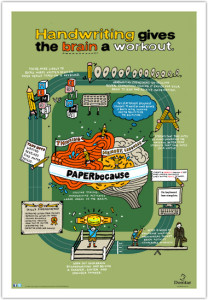By Bev Munday, Director of Education
As we use technology more and more, it appears that the art of handwriting is being lost, especially among younger people. To some, the topic might even be obsolete. My own three daughters now do so much using their computers, tablets, and phones that they rarely pick up a pencil or pen. They hand in assignments via e-mail or platforms like Blackboard, and their teachers and professors seemingly no longer want to have to read their handwriting.
 So, why should parents care whether their child learns handwriting? PAPERbecause (a paper designer and manufacturing company) provides articles and activities to promote teaching young people to write with a pencil and paper. And, Stacy Tornio of We Are Teachers outlines some of the reasons why handwriting should be taught, including the following benefits:
So, why should parents care whether their child learns handwriting? PAPERbecause (a paper designer and manufacturing company) provides articles and activities to promote teaching young people to write with a pencil and paper. And, Stacy Tornio of We Are Teachers outlines some of the reasons why handwriting should be taught, including the following benefits:
- Handwriting develops children’s fine motor skills. Anecdotally, the lead teacher in a preschool that one of my daughters volunteered at said 3- and 4-year-olds were coming to the program knowing how to “swipe” on a tablet or touchscreen, but that their fine motor skills were lacking because their parents were no longer giving them crayons and pencils to scribble and “write” with at an early age. In addition, because the children weren’t seeing their parents write either, no modeling was being done in the home.
- Good handwriting skills lead to stronger academic performance. One study published in the Journal of Early Childhood Education found that children who had good fine motor skills from handwriting instruction outperformed their peers on both reading and math by 2nd grade.
- Using pen and paper boosts memory. When we write something down, we tend to remember it longer. It sticks in our memory. Handwriting is still better than taking electronic notes.
- Handwritten correspondence is more meaningful. When did you last receive a handwritten note or letter? Recently, I was so delighted to receive letters from two older friends of mine. I read and re-read them several times and kept them. I also still have the love letters that my husband and I wrote to each other when we were first engaged. As we lived apart for two years, we would write to each other every week, and I hope these letters will be treasured by our children and grandchildren. (By contrast, my daughter and her husband would Skype with one another when they were apart—no written love letters for them to treasure!)
- Handwriting is a practical skill for daily life. It is useful for taking quick notes, keeping a to-do list, and writing a check (does anyone still do that? I do occasionally!).
Finally, not all handwriting has to be done on paper. My husband was diagnosed with dyslexia at university. His handwriting is not good, and he sometimes even has trouble reading what he has written! However, he can still write faster than he can type, especially when he is in a lecture or meeting, so he makes use of technology to aid with his handwriting and note taking. He uses an app called “Notes Plus,” which allows him to write on his iPad with a stylus and draw pictures and diagrams. The program recognizes what he has handwritten and turns it into text so anyone can read it. It is also great for visual learners.
Further Reading
How important is learning handwriting to you? Please share your thoughts along with any favorite handwriting resource or activity you would recommend.






